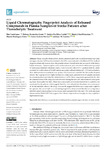Liquid chromatography fingerprint analysis of released compounds in plasmas samples of stroke patients after thrombolytic treatment

View/
Use this link to cite
http://hdl.handle.net/2183/37131
Except where otherwise noted, this item's license is described as Creative Commons Attribution 4.0 International License (CC-BY 4.0)
Collections
- Investigación (FCS) [1293]
Metadata
Show full item recordTitle
Liquid chromatography fingerprint analysis of released compounds in plasmas samples of stroke patients after thrombolytic treatmentAuthor(s)
Date
2023-01-05Citation
Castellanos M, Fernández-Couto D, Da Silva-Candal A, Feal-Painceiras MJ, Rodríguez-Yáñez M, Gubern-Mérida C, Sánchez JM. Liquid chromatography fingerprint analysis of released compounds in plasmas samples of stroke patients after thrombolytic treatment. Separations. 2023;10(1):34.
Abstract
[Abstract] Plasma samples obtained from stroke patients treated with recombinant tissue-type plasminogen activator (rt-PA) and not treated with rt-PA were evaluated with different HPLC methodologies to obtain information about the possible release of small molecules as a result of the thrombolytic treatment. Plasma samples, without derivatization and derivatized with 6-aminoquinolyl-N-hydroxysuccinimidyl carbamate (AQC), were evaluated with a HPLC gradient method, which consisted of a mobile phase of 10 mM ammonium acetate buffered solution (pH = 5.3) and acetonitrile. Three different detection methods were applied: UV, fluorescence, and ESI-MS. The results obtained showed that a group of new highly hydrophilic compounds appeared in most samples analyzed from treated patients, just after the administration of rt-PA. These compounds appeared shortly after the administration of the drug and were detected during the first 24 h after treatment, disappearing from plasma after this time. These new compounds were not detected either in controls or in non-treated stroke patients, which suggests that they were released into the plasma as a consequence of the thrombolytic effect of the drug. Our results suggest that these new compounds might be free glycans. The use of AQC as a derivatizing reagent has demonstrated that the new compounds detected cannot contain primary or secondary amine groups in their structure. The molecular mass determined by ESI-MS (821 Da) suggests that if these compounds are free glycans they might be a high-mannose type.
Keywords
Thrombolysis
Sub-products
Recombinant tissue plasminogen activator
Ischemic stroke
Sub-products
Recombinant tissue plasminogen activator
Ischemic stroke
Editor version
Rights
Creative Commons Attribution 4.0 International License (CC-BY 4.0)
ISSN
2297-8739






